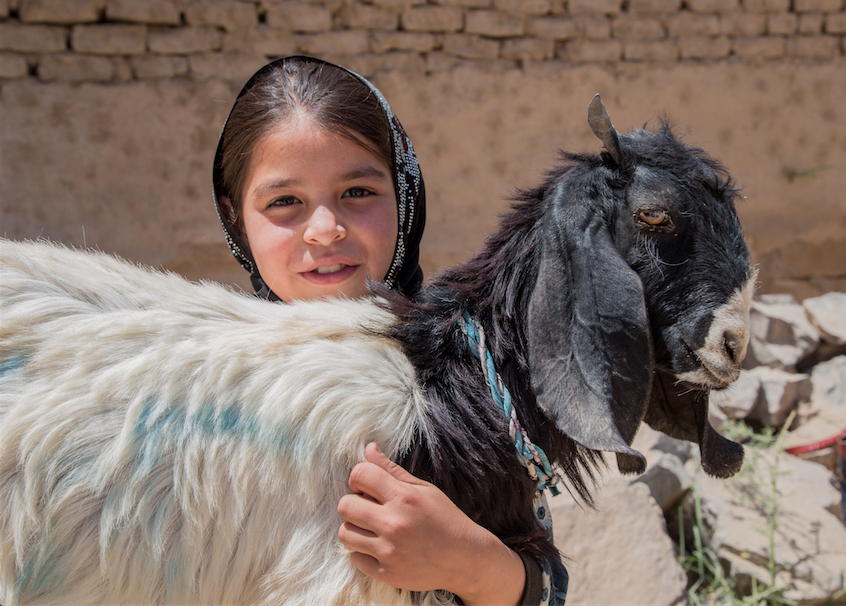Change Arrives on the Back of a Goat

Nazbibi, 10, runs quickly to the other side of the yard and returns with her hands full of grass. She takes a step toward where two goats graze and puts the bunch of grass close to their mouths. Nazbibi and her family recently received the female goat and her two kids from World Vision Afghanistan (WVA). She and her five siblings will be able to harvest the milk and make other products.
"I named the white one Sefidak and the other Siyagak. I like to feed them!” She points to the two smallest ones, “especially Sefidak and Siyagak. Mohammad [Nazbibi’s older brother] feeds the mother.”
“I used to have 12 sheep,” he says. “I had to sell them one by one."
Nazbibi’s father, Ismael, is a wheat farmer and his income isn’t sufficient to meet the needs of his family. “I used to have 12 sheep,” he says. “I had to sell them one by one. It was during a drought and we didn’t have anything else to fill our bellies. I sold them to buy food and other essentials.”
From April to September Ismael is busy with farming, but during winter, when the mountains and plains of Langar are covered in snow, he has to search out new income, which usually comes through daily labour in Qala-e-Now city, the provincial capital.
Of the six children, three of them are going to school and need supplies, and if any of them get sick they need money to buy medicine. Sometimes Ismael is forced to borrow money from neighbours, which he intends to return when he sells his wheat crop.
An assessment carried out by WVA in 2016 revealed that over 75 per cent of families in Langar District of Badghis Province belong to the ‘poor’ or ‘poorest of the poor’ economic categories, including Nazbibi and her family.
The assessment also showed that around 40 per cent of families in this part of Afghanistan struggle with moderate to severe hunger as, on average, one family member per day must go without eating because there is not enough food.
Animal husbandry for vulnerable families
World Vision Afghanistan, through the multi-sectoral Area Integrated Programme funded by World Vision Hong Kong and Korea, supports community to engage in alternative small-scale animal husbandry activities and participate in knowledge-improving sessions.
Programme staff have distributed Chili goats, a mother and two young, to certain vulnerable groups, such as women and woman-headed households, families with a large number of dependents, low income families, families without land and people with disabilities. The Chili variety of goat produces large quantities of milk and is well-adapted to the Badghis climate.
Having a large family with low income, Ismael’s wife Zainab was selected as a beneficiary of the programme. Along with the goats she was also equipped with the knowledge she needs to take care of them.
Zainab and other beneficiaries have been linked to the Department of Veterinary Services so that government extension services are available to them for stockbreeding, disease prevention and related services.
It has been 4 months since the family has received the goats. “The mother goat gives me half a litre of milk per day,” says Zainab. “Such types of goat produce almost 1.5 litres of milk per day in the spring. I make yoghurt with the milk [which] my kids like to eat with dried mint. When we don’t have other food for lunch or dinner, we eat yoghurt and homemade bread.”
“Goat milk is a source of calcium, protein, and other essential nutrients that growing children need. The animals can develop in harsh climates while eating any type of grass and producing a greater quantity of milk,” says Obeidollah Dorani, a World Vision Livelihoods Manager.
Before, Zainab says, the family couldn’t afford to regularly buy milk or other dairy products, but since they have received the goats they have fresh yoghurt almost three days a week. “I am looking forward to spring!” She says, smiling. “[With a greater amount of milk] I can make different things such as butter…and dried whey, which I can [send with] my children to school to eat during breaks.”
In order to increase the number of goats for each beneficiary, two male goats were given to a couple of villagers for breeding purposes. In exchange for taking care of the male goats the two villagers will receive goat kids later on from other beneficiaries.
According to Dorani, “A healthy well-fed goat can bear 1-2 kids twice a year for 4-5 years. Families can harvest 1.5-2 litres of milk for 3 to 4 months after [the mother goat has given birth]. Hopefully, each year families can benefit more from the goats and eventually can sell some of the dairy products to cover other expenses.”
In Badghis, drought has driven crop failures, leading to malnutrition and chronic health problems. In this province, the calorie deficiency per person is 50 per cent worse than the national average and communities in the area experience an average of six hungry months per year. More than 80 per cent of adults are under-employed, forcing migration for work.
World Vision works in Badghis to ensure that communities are more resilient and are better able to promote child well-being, improve living standards and initiate change.
Nazbibi and her siblings and her friends

